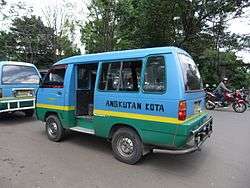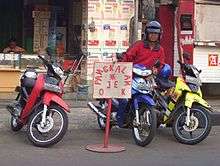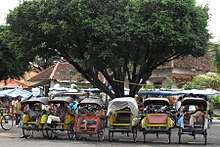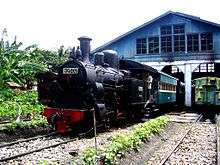Ambarawa
Ambarawa is a small town in the mountains south of Semarang, in Central Java province, Indonesia.
Understand
Orientation
Ambarawa is a small town located at the highlands of Central Java. It lies in the junction of several larger cities, such as Semarang, Yogyakarta, Salatiga and Surakarta. It has served as an economic and military hub town for centuries. The town is large enough to have a shopping center of its own, yet small enough that the shopping center lies less than a mile away from rice paddy fields.
Geography and climate
The town is at the edge of a natural depression between Mount Telomoyo, Merbabu, and Ungaran that centers on Lake Rawapening. The town's climate is somewhat cooler than the low-lying Semarang in the north. The town is divided in two, with the urban north having a hilly terrain, and the agricultural south being much flatter, and in rainy seasons, occasionally turning into a swamp (rawa).
Scenery
To the north, you can see Mount Ungaran, while to the south, Mount Telomoyo and Merbabu are also visible, especially in the morning, before clouds move in to cover their peaks. You can also see Lake Rawapening and the wide paddy fields to the south and southeast.
Get in
By car
Ambarawa is 12 km from Salatiga, and 40-50 km from Semarang. Visitors coming from Semarang to Yogyakarta or Magelang (or vice versa) will pass this particular town en route to their destination. Visitors from Salatiga will be provided road signs to Ambarawa.
By bus
There are three options for getting to Ambarawa via buses:
- 🌍 Ambarawa Terminal (Terminal Ambarawa). A bus terminal serving local public transportation vehicles and travel buses from other cities, such as Semarang, Yogyakarta, and Surakarta.
- 🌍 Bawen Terminal (Terminal Bawen). A larger bus station which serves as a transportation hub between intercity, and inter-provincial transportation. It's outside of Ambarawa, and visitors may continue to Ambarawa via Prona/Isuzu (listed below). Visitors coming from Semarang may get here using a TransJateng bus.
- Local, un-ticketed buses where one pays on the spot for a ride. Smaller buses can pick-up or drop passengers anywhere, while larger buses usually stops at haltes (bus stops). Common routes for these buses include: Ambarawa-Ungaran, Semarang-Bawen, Semarang-Salatiga, Semarang-Magelang.
By prona/isuzu
A prona/isuzu is the local term for a large angkot (an Indonesian type of shared taxi, not unlike the Philippine jeepney) which, despite the name, is made from repurposed Mitsubishi shuttle vehicles. Visitors to Ambarawa may directly hitch a ride with one of these at roads where they pass through. Routes passing Ambarawa (or nearby places) are: Ungaran-Ambarawa-Jambu, Ungaran-Bawen-Salatiga, Salatiga-Banyubiru-Ambarawa.
Get around
By angkot

Angkots are an Indonesian type of shared taxi, not unlike the Philippine jeepney. A ride costs around Rp5,000 to Rp10,000 in cash (paid directly when one arrives at the destination), depending on the distance taken and the types of angkot used (regular or prona/isuzu). There are several regular angkot routes in Ambarawa, differentiated by color, listed below:
- Yellow angkot with red bottom: Praja Market - Dr. Cipto Statue - Gamblok - General Sudirman Square - Indonesian Railway Museum - Ambarawa Police Precinct - Palagan Museum - Ambarawa Terminal and Grand Mosque - St. Joseph's Catholic Church - Jambu - Palagan Museum - Hok Tik Bio Chinese Temple - Dr. Cipto Statue - Praja Market
- Yellow angkot with blue bottom A*: Praja Market - Dr. Cipto Statue - Gamblok - General Sudirman Square - Banyubiru - Brongkol - Banyubiru - General Sudirman Square - Indonesian Railway Museum - Ambarawa Police Precinct - Palagan Museum - Hok Tik Bio Chinese Temple - Dr. Cipto Statue - Praja Market
- Yellow angkot with blue bottom B*: Bawen - Praja Market - Dr. Cipto Statue - Gamblok - General Sudirman Square - Indonesian Railway Museum - Palagan Museum - Hok Tik Bio Chinese Temple - Dr. Cipto Statue - Praja Market
- Light Blue Angkot: Kebonsari - Kerep Marian Cave - Ambarawa Terminal and Grand Mosque - Palagan Museum - Ambarawa Police Precinct - Indonesian Railway Museum - General Sudirman Square - Ambarawa Hospital (and vice versa)

as well as two Prona/Isuzu (large angkot) routes, listed on the angkot's windshield:
- Ambarawa-Banyubiru Salatiga route
- Ungaran-Ambarawa-Jambu route
Ask the driver "Banyubiru" or "Bawen" to determine route. Route A is for "Banyubiru," and route B is for "Bawen".
By ojek

Ojeks are an Indonesian motorcycle taxi, whose service can be obtained at local ojek stops (Pos/Pangkalan Ojek) where drivers rest. As with the angkot, ojek drivers accept cash on arrival, with prices being dependant on how long the route is. However, nearly all ojek drivers have very limited knowledge on English, and many usually spike prices up on foreign tourists. An online version of ojek exists, as listed below.
By online ride-hailing apps
Two online ride-hailing services operate in Ambarawa, Go-Jek and Grab, known to locals as "Ojek Online". Visitors may use to hail a motorcycle or automobile taxi, and both accept cash or in-app payments. As the price for a trip is set before the driver is hailed, the price of a trip is fixed and constant, and is known to locals for being cheap. Both apps are available in English.
By rickshaw (becak)

Rickshaws can be commonly found at Lanang Market (Pasar Lanang), in front of the entrance to the Indonesian Railway Museum. Rickshaw rides provide a touristy, old-timey feel to Ambarawa, yet since the seat is in front of the driver, one must consider whether the motorcycle and car exhaust is worth it, especially if one's route passes through a lot of large roads. Not to mention how

By horse carriages (delman/dokar)
Horse carriages, much like rickshaws, can be found near the entrance to the Indonesian Railway Museum. As another 'vintage' way to travel around Ambarawa, a horse carriage is a better, although a more expensive, alternative to a rickshaw, since a passenger won't be the direct target of an car's exhaust.
On foot
Walking around Ambarawa presents some challenges of its own. Although Ambarawa is somewhat cooler than the rest of Indonesia, midday temperatures are still high enough for one to have heat stroke if one does not take rest. Walking a short distance, on the other hand, is okay, since there are quite a lot of trees providing some shade in the streets. However, as with much of Indonesia, the sidewalks are very narrow and may be a shock to those who are not used to it.
Visit


- 🌍 The Indonesian Railway Museum (Museum Kereta Api Ambarawa), ☎ +62 298 591035. A railway museum, exhibiting many old locomotives, carriages, and other train paraphernalia. Before its current use as a museum, the station was decommissioned in the 1970s. It is possible to get a ticket for a diesel train trip to the nearby station in Tuntang on weekends, through which visitors can see the vast rice fields of Ambarawa, and the panoramic view of Lake Rawapening and Mount Merbabu, Telomoyo, and Ungaran. Rp5,000 for students, Rp10,000 for domestic visitors.
- 🌍
Palagan Ambarawa Monument. A monument to commemorate the Battle of Ambarawa, in which the Indonesian army defeated the British and Dutch troops in 1945. It houses several weapons and vehicles used during the National Revolution Period.
 St. Joseph's Catholic Church
St. Joseph's Catholic Church - 🌍 Fort Willem I (Benteng Pendem). An 18th-century Dutch fortress which was used as a Japanese internment camp for Europeans during World War II, with the southern part now serving as a penitentiary facility and the northern part serving as the home of several of the facility's wardens and as a tourist destination. Rp5,000.
- 🌍 St. Joseph's Catholic Church (Gereja Jago), Jl. Mgr. Soegijapranata, No. 56, Panjang, Ambarawa, Semarang, Jawa Tengah 50614 (500 m from Ambarawa Terminal), ☎ +62 298 591028, fax: +62 298 596344. A Dutch church built in the early 1900s, this church was the center of missionary activity in Ambarawa. No entry fee.
- 🌍 Eling Bening. A resort on a hilltop at Bawen, with a stunning view of the Mount Telomoyo, Merbabu, Lake Rawapening and Ambarawa.
Do
- Ride the diesel train from the Ambarawa station to Tuntang station, or pre-order a ticket for a steam train trip to Bedono station.
- Visit the eerie and rundown Fort Willem I.
- Go fishing on Lake Rawapening using the local "Swamp Rod" (Pancing Rawa) using algae (lumut) as bait. These can be purchased at the local tackle shops (Toko Pancing) or rented from vendors at the edge of the lake.
- Swim at Eling Bening's Pool with a view of the mountains and fields.
Buy
Eat
Drink
Eva Coffee House - a coffee shop whose coffee comes from a local farm of the same owner. They also sell gudeg manggar (young coconut flowers stewed with coconut milk and some herbs). Jl Raya Bedono, Ambarawa.
Sleep
Connect
The telephone area code of Ambarawa is +62298.
Go next
- North
- Close by
- South